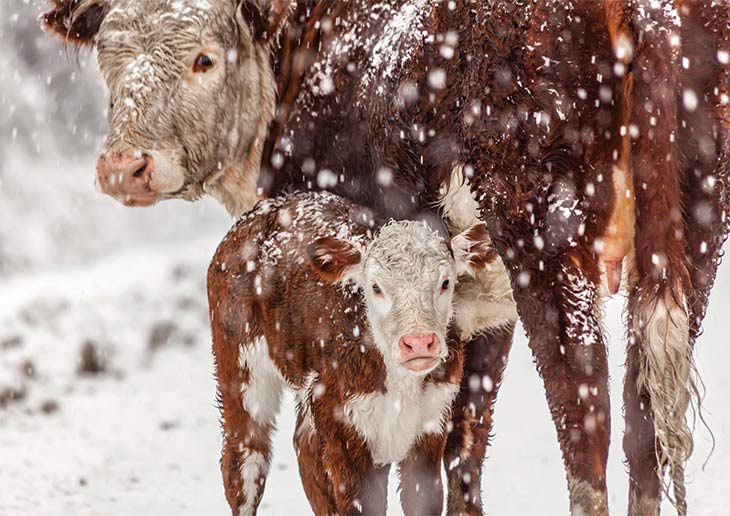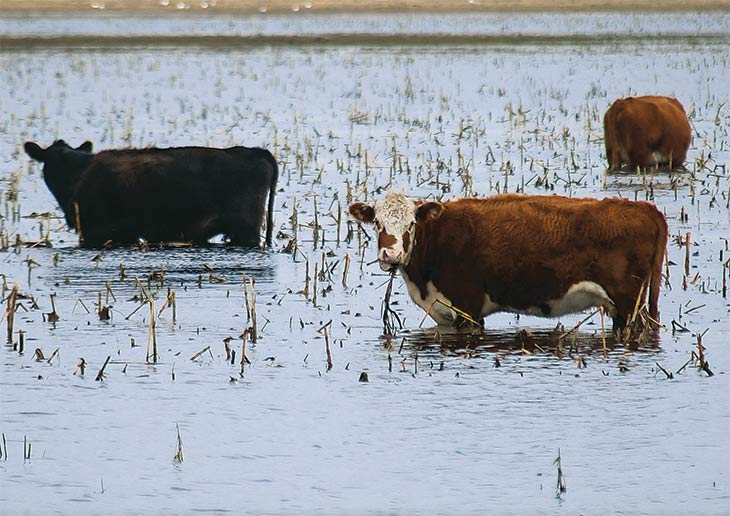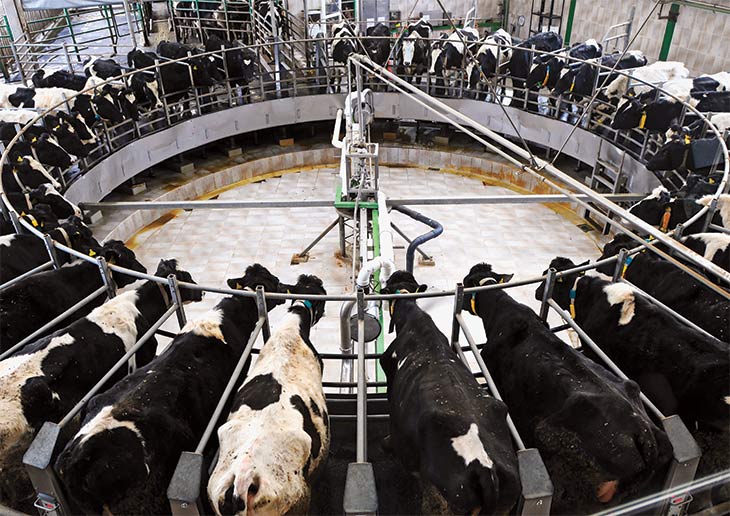
Photo courtesy of Getty Images
When Texas cattlemen Gregg Sides and Joe David Yates wanted to reduce their ranching risk a few years ago, they turned to their Farm Credit lenders for livestock insurance. Their insurance purchases have paid off, both in peace of mind and covering losses.
Mortality Insurance Pays After Blizzard
Sides has seen plenty of cattle-killing weather in the Texas Panhandle, where he raises calves on grass and winter wheat near Dimmitt and then finishes them in his own feedlot or sells them to other feeders.
Key Benefits of Livestock Insurance
- It reduces your risk; you’ll be reimbursed for losses.
- You can plan your budget more accurately.
- Lenders may be more willing to provide loans, knowing you are protected from losses.
Recognizing that weather is one risk he can’t control, Sides decided in 2013 to insure against catastrophes by purchasing livestock mortality insurance. This type of coverage insures the herd in the event of death from natural causes such as a blizzard, tornado, lightning, fire or accident.
“If a tornado hit, I could be back to square one,” Sides says. “I’m glad I have this insurance.”
To date, he has filed one claim — after the “Goliath blizzard” that hit the southern Plains in December 2015 — and was reimbursed for the loss of a number of cattle after meeting his policy deductible of $10,000.

Photo courtesy of Getty Images
“Natural disasters of recent years — the drought of 2011, the Goliath blizzard of 2015, the Panhandle fires and Hurricane Harvey of 2017 — are fresh reminders of the benefits of purchasing livestock mortality insurance,” says Sides’ agent, Janell Turner, insurance specialist at AgTexas Farm Credit Services in Amarillo. “Claims spiked after Goliath, and sales continue to climb.”
Market Risk Coverage Makes for Better Sleep
Meanwhile, in the Hill Country of Central Texas, cow-calf producer Yates of Llano advocates for insurance that protects livestock growers in the marketplace.
Yates, who serves on the board of Capital Farm Credit, learned about livestock risk protection (LRP) when the association began offering crop and livestock insurance a few years ago. With LRP, he sets a floor price for a specific number of head for a specific time period.
"The insurance helps me sleep better at night. It’s another management tool in the arsenal to prevent dramatic loss."
– Joe David Yates
To date, he has collected insurance payments once, when the market price dropped below his floor price — and he plans to continue the coverage.
“The insurance helps me sleep better at night,” Yates says. “It’s another management tool in the arsenal to prevent dramatic loss. It’s good for Farm Credit and other bankers, too — it helps assure that you can repay your loans.”
Before Yates learned about LRP insurance, he purchased futures hedging products from commodities brokers, but grew tired of paying margin calls when the equity in his account fell below his maintenance margin.
“When you purchase livestock insurance, that’s your last expense,” he says. “You can plan your fixed costs.”
How Market Risk Coverage Works
Cattle market volatility in the past three years has been driving the growth of market-based livestock insurance, according to Charlie Johnson, an insurance representative with Texas Farm Credit Services.
Johnson, who has a commodities brokerage license, reports that his customers find livestock risk protection insurance simpler than brokerage products.
“You don’t have to go through a broker, there’s no brokerage fee, and there are no margin calls,” he says.
Livestock Risk Protection (LRP) does not place a minimum on the number of head covered; therefore, it especially benefits smaller operators. In comparison, commodity brokers usually require producers to contract for a truckload, or 50,000 pounds of beef on the hoof.
With LRP insurance for feeder cattle, a producer can purchase coverage for as many as 1,000 head that are expected to weigh up to 900 pounds at the end of the insurance period. Periods range from 13 to 52 weeks, although coverage is rarely offered for more than 39 weeks. The policy holder is limited to insuring 2,000 head each year.
Coverage applies to beef steers and heifers, including predominantly Brahman as well as dairy cattle. Prices vary according to the number of head, the type, weight at ending date, coverage level, floor price and time period. At the end of the insurance period, if the national cash index falls below the producer’s floor price, the producer is paid the difference.
LRP is also available for fed cattle, swine and lambs.
No Cost to Apply
A cattleman himself, Arthur “Tootie” Ilse, who heads up Capital Farm Credit’s insurance operations, encourages livestock producers to at least fill out the LRP application.
“It doesn’t cost a nickel” to apply, he says — then you can activate the insurance quickly when the time is right.
Before selecting livestock market insurance, Johnson suggests that producers determine their breakeven point based on today’s market prices.
“As with any insurance product, you hope you don’t have to use it — you hope the market goes up, not down,” says Johnson. “But your goal is to select a floor price at or above your breakeven point.”
USDA’s Risk Management Agency (RMA) administers LRP insurance, which only USDA-certified agents can sell. The RMA sets the rules, time periods and price — and usually subsidizes the price by 13 percent — therefore the only difference between insurance sellers comes in the level of service and expertise they provide.
However, Ilse points out that purchasing livestock insurance through Farm Credit offers advantages.
“We pay attention to what’s going on in the cattle market, and sometimes we contact customers when it’s a good time to purchase insurance,” he says.
– Nancy Jorgensen
Interest in Livestock Insurance Builds
First piloted by the USDA in 2007, livestock insurance is generally not as well-known as crop insurance. But that’s changing, as producers learn about the benefits.
“We expect interest in livestock insurance to build,” Turner says. “The cost of land and feed continues to squeeze margin potential. With increased costs, coupled with a volatile market, capital requirements for a livestock producer are much greater than they used to be. Livestock insurance is a great way to protect your investment.”
Congress will soon debate the next farm bill, which will determine its future. Farm Credit representatives recently visited Washington, D.C., and requested support for both crop and livestock insurance.
“Overall support was encouraging,” Turner says. “Congress is aware that this is the most important safety net for America’s farmers and ranchers.”
Arthur “Tootie” Ilse, director of crop insurance operations for Capital Farm Credit, echoes Turner’s comments.

Photo courtesy of Shutterstock.com
“We sell insurance, but what we’re really doing is protecting the family farm from financial disruption — and that’s more important than anything. This type of coverage could keep a producer in business for another year,” says Ilse. “I’ve had a few customers tell me that if it hadn’t been for our insurance, they’d have to do something else.”
– Nancy Jorgensen
Choose From Five Insurance Programs
Options for Beef, Dairy, Swine and Lambs
The following types of livestock-related insurance are available through some Farm Credit associations.
These products are administered by USDA’s Risk Management Agency (RMA), which sets national rules and prices:
- Livestock risk protection (LRP) covers a drop in the market price on feeder cattle, fed cattle, swine and lambs. You secure a floor market price for a certain number of head and for a specified period. If, at the end of the period, the national cash index is below your policy’s floor price, you’re reimbursed for the difference.
- Livestock gross margin (LGM) insurance covers losses by insuring expected gross margin versus actual gross margin in yearling and calf-finishing operations, dairy and swine. For dairy producers, for example, it provides protection if feed costs rise or milk prices drop.
- Pasture, rangeland and forage insurance (PRF) covers loss of pasture and forage due to lack of rainfall and declining vegetation.
Prices and policies may differ for these products, which are offered by private insurers:
- Feedlot, dairy and pasture insurance covers perils including fire and tornadoes.
- Full mortality insurance protects against death of livestock from natural causes including drowning, sickness, disease, accident, fire and lightning. It’s available for cattle and horses, and for show, breeding and exotic animals.
For details about RMA-administered insurance products, visit www.rma.usda.gov, and click on “livestock policies” or search for “pasture, rangeland and forage pilot program.”
– Nancy Jorgensen
Contact your local Farm Credit association for more information. Not all Farm Credit associations offer livestock insurance, but they may be able to refer you to another association or a private agent in your state that does.